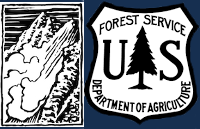24-25
Good skiing, but...
The skiing was good and non reactive on the main East face next to the skin track. The North gullies into Naya Nuki creek and the the lower/steeper gullies to the south were highly reactive and entraining lots of snow.
Hot and wet
The 12" of snow since yesterday fell right-side-up and had little to no slab properties. This new snow rests on a stout melt-freeze crust from the high temperatures last week. Photo: GNFAC
Forecast link: GNFAC Avalanche Forecast for Mon Mar 31, 2025
Small wind slabs and good skiing
Skied the Banana today with 8-12” of new snow that has mostly bonded. The snowpack below the new snow had froze over night and was well consolidated.
Observed a layer of graupel (3-4mm grains) at the new/old interface on the NE ramp starting at 8600’ and clearing up after 8700’. This layer created some reactivity in the storm snow.
Wind slabs <6” had formed on N and NE aspects. We had one small release in the bottom of the couloir measuring ~10x20’ and running ~50’.
Other than that, the skiing was amazing and manageable.
New Snow in Hyalite
We toured up to Mt Blackmore today and found that winter had returned to the high peaks over the last two days. Since yesterday morning, high elevations around Hyalite have received about 12" of new snow (1.2" SWE). The parking lot had around 3", the trail around 6" and at elevations above 8500' the numbers corresponded well to the Shower Falls SNOTEL.
The parking lot and lower trail softened up throughout the day and temperatures were above 32 degrees at the car at 3pm. In the alpine around 9800', temperatures were just below freezing (31 degrees) around 1pm. Despite our layers and gear getting a bit soggy, the snow from last night remained dry.
A mix of rimed precipitation particles and graupel fell throughout the day. Previous and current winds were calm; there was little to no wind effect on the new snow. we saw no cracking or recent drifts. The 12" of snow since yesterday fell right-side-up and had little to no slab properties. This new snow rests on a stout melt-freeze crust from the high temperatures last week.
Our main avalanche hazard today were dry-loose avalanches. Despite lots of traffic in this zone today, we only saw a handful of slides in steep terrain, and all were relatively small and did not entrain much snow. Conditions can and will change quickly if winds increase or the sun comes out and warms the new snow, but for now, we were happy to find good powder skiing.
GNFAC Avalanche Forecast for Sun Mar 30, 2025
<p><span><span><span><span><span><span>Near Bozeman, Big Sky and Cooke City, where more new snow has fallen, avalanches</span></span></span></span></span></span><span><span><span><strong><span><span> </span></span></strong></span></span></span><span><span><span><span><span><span>involving the new snow are possible and could slide as </span></span></span></span></span></span><span><span><span><strong><span><span>wind slab avalanches</span></span></strong></span></span></span><span><span><span><span><span><span> or </span></span></span></span></span></span><span><span><span><strong><span><span>loose snow avalanches</span></span></strong></span></span></span><span><span><span><span><span><span>. Wind has been fairly minimal, but slopes where the new snow has been drifted or stiffened by the wind are more likely to avalanche.</span></span></span></span></span></span></p>
<p><span><span><span><span><span><span>If you plan to travel on steep slopes, assess the stability of the new snow and monitor how it changes throughout the day. Push on small test slopes with clean runout zones to see how the snow reacts. As you travel watch for cracking across the surface as a sign you could trigger slab avalanches, and look for snow being drifted as a sign slabs are growing and possibly becoming more reactive.</span></span></span></span></span></span></p>
<p><span><span><span><span><span><span>Warm temperatures and any sun will make the new snow moist and more cohesive and could cause loose snow or </span></span></span></span></span></span><span><span><span><strong><span><span>storm slab avalanche</span></span></strong></span></span></span><span><span><span><span><span><span>s to break larger and be easier to trigger. Have a plan to find lower angle terrain or slopes with colder snow if you feel the snow get heavy or moist.</span></span></span></span></span></span></p>
<p><span><span><span><span><span><span>Avalanche danger is MODERATE near Bozeman, Big Sky and Cooke City.</span></span></span></span></span></span></p>
<p><span><span><span><span><span><span>Aside from instability involving the new snow, the snowpack is generally stable. Near Island Park and West Yellowstone, where less new snow has fallen, large avalanches are unlikely. Small </span></span></span></span></span></span><span><span><span><strong><span><span>wind slab</span></span></strong></span></span></span><span><span><span><span><span><span> or </span></span></span></span></span></span><span><span><span><strong><span><span>wet loose avalanches</span></span></strong></span></span></span><span><span><span><span><span><span> in isolated areas are something to keep in mind. These would only be an issue in extreme terrain where being knocked over would have big consequences, like above cliffs or on long, firm steep slopes. </span></span></span></span></span></span></p>
<p><span><span><span><span><span><span>The avalanche danger is LOW near West Yellowstone and Island Park.</span></span></span></span></span></span></p>
Point releases, wet loose in Beehive/Middle Basin
Toured around Beehive and Middle Basins this morning, finding predictably bulletproof snow on most aspects but decent turns aided by the 2-4 inches of snow from last night on northerly terrain that hadn’t been destroyed by the sun this week. There were a few brief moments of direct sun throughout the morning, which almost instantaneously triggered point releases from steeper rocky terrain. On the way back through Beehive we observed some much larger debris piles that weren’t there this morning from the steel rocky face between the Going Home chute and the prayer flags.
